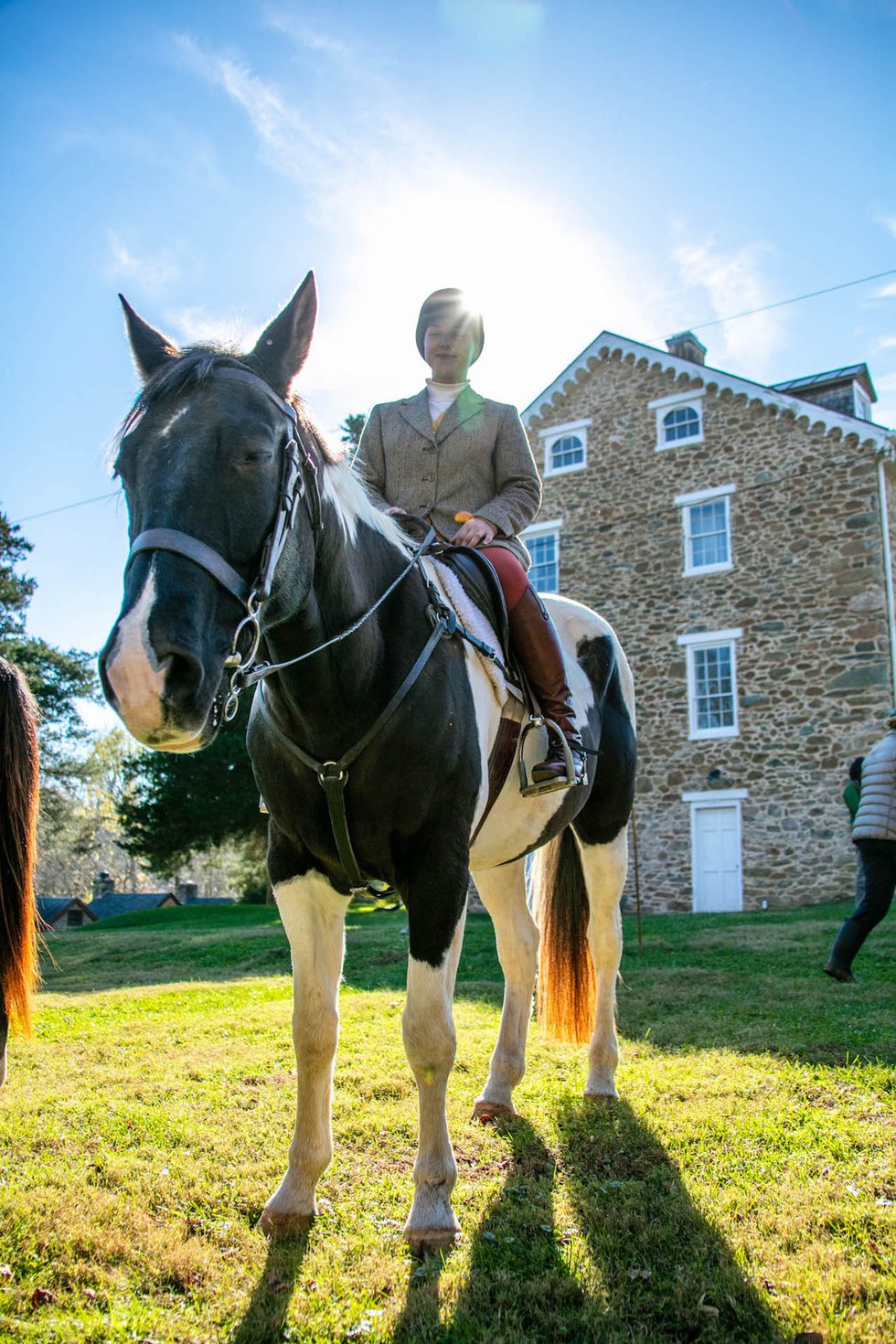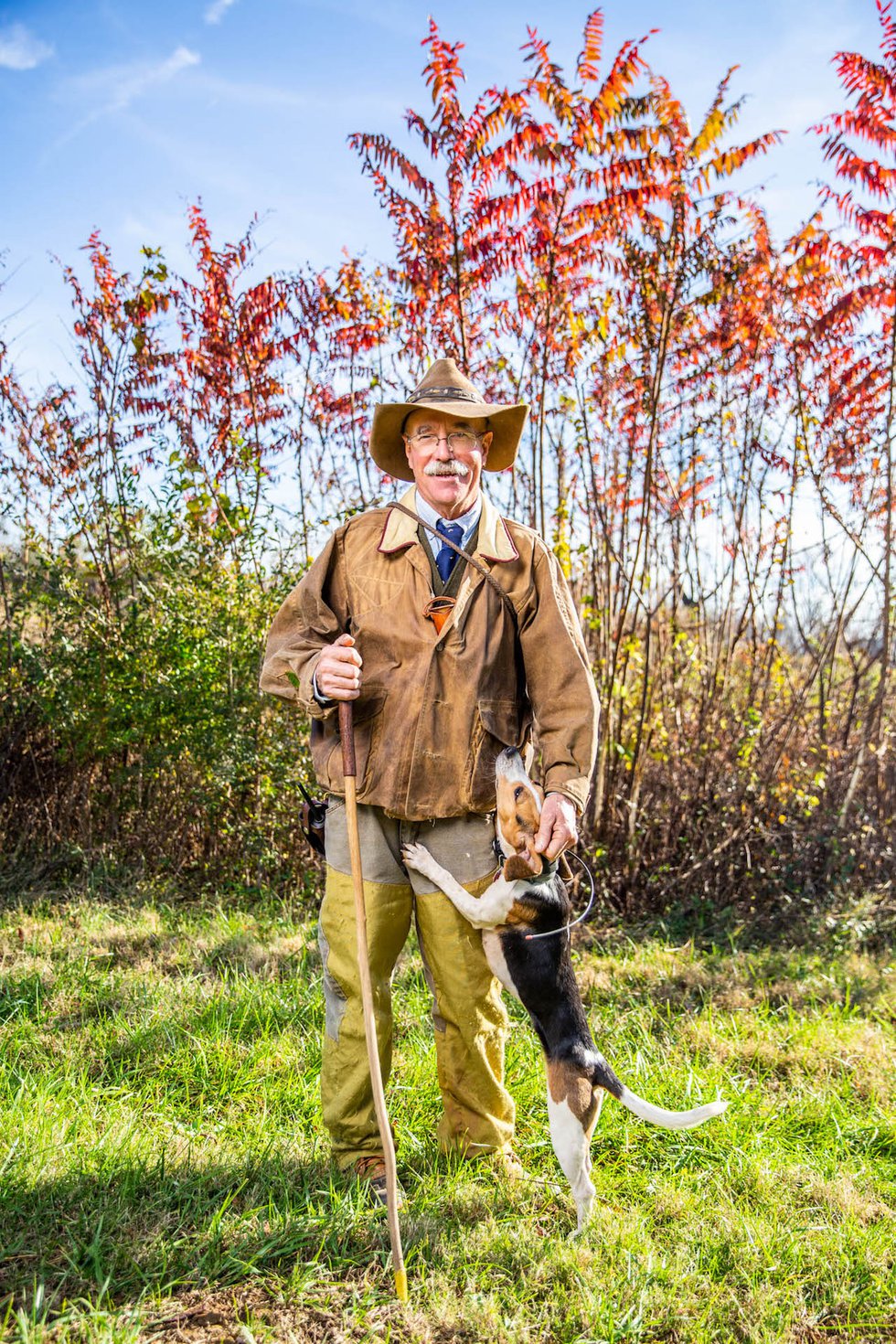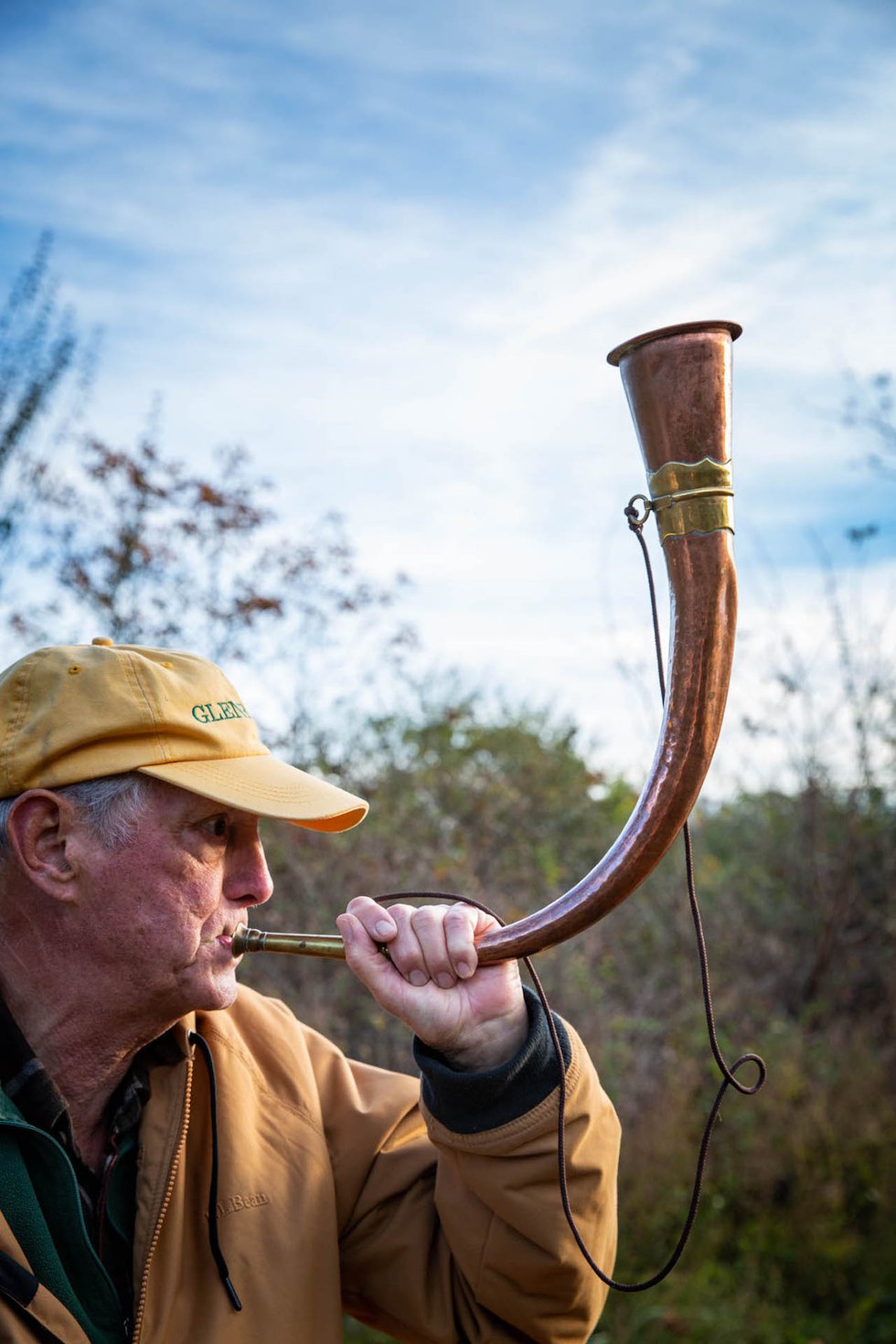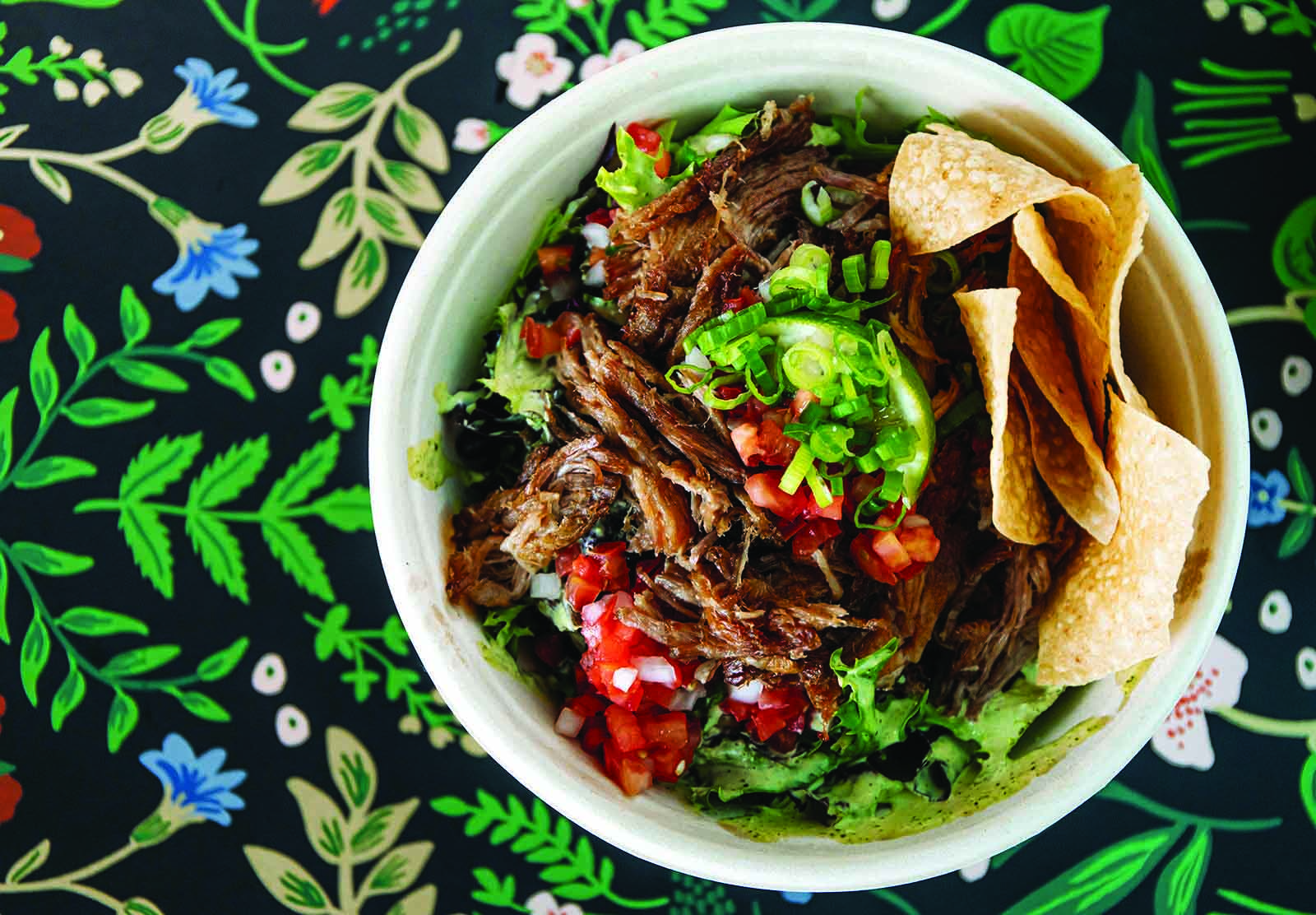We take to the field to appreciate the art of hunting with hounds.

Betsy Park with the Sandanona pack.
Photography by Ryan Donnell
It was not without a bit of trepidation that I drove onto the grounds of the National Beagle Club, 512 acres of wooded hill and dale in the first range of the Blue Ridge Mountains on what was once part of President James Monroe’s Oak Hill Plantation, last November for the Fall Beagle Pack Trials. A decided newcomer to the sport, I was unsure what to expect—a month earlier I had no idea hunting with beagles even was a sport, let alone that its national headquarters were in Aldie, five miles east of Middleburg. My wife and I were to join the field. “Wear lots of layers and waterproof stuff, and high waterproof boots especially,” a friend had warned the day before. “The land is swampy in parts, and you’ll be roaming all over it.” And even more crucially: “Whatever you do, don’t call the beagles ‘dogs.’ They’re hounds. Everyone will correct you!”
Joining the Field

To bring you up to speed: Beagling—hunting with a beagle pack—is a sport that dates back to the ancient Greeks. It eventually crossed the Atlantic with the Brits and took hold in the northeast. While beagles can make for button-eyed, tail-wagging house pets, they are scent hounds, bred for eons to live and work in hunting packs and to follow a scent. The National Beagle Club (NBC), founded in Boston in 1887, moved to Aldie in 1916 to take advantage of its abundant and charming farmland, fair weather, and a handsome, if downtrodden, fieldstone academy building (The Loudoun Agricultural and Chemical Institute) suitable for a clubhouse and headquarters. Like its cousin, foxhunting, beagling entails a good deal of ritual, devotion—the pack has to be fed, maintained, and exercised daily year ’round—and skill, as well as an appreciation for socializing and enjoying nature.
Although NBC’s lineage runs deep and its various hunt clubs date back generations, the society is more down-to-earth, both literally and figuratively, than the equestrian foxhunting set. Beagles (and basset hounds) are considered “foot hounds” and hunt rabbits, which travel in a much smaller circle than foxes. The hunters and “the field”—the spectators who follow the pack to observe the action—go on heel and toe.
We arrived at lunchtime and just happened to sit down to eat in the basement of the handsomely restored 1855 stone clubhouse next to John Marshal, one of the venerable old-timers at this multigenerational affair. He eased us in with his offbeat sense of humor and took us under his wing. Soon after, Billy Bobbitt, a past president of the club who lives and keeps a beagle pack called Glenbarr in Rockbridge County, whisked us out to our quarters, one of the fieldstone and log cabins that line the lawn behind the clubhouse. Think rustic: bunk beds, no plumbing, heating by fireplace and spirits—aging bottles kindly supplied.

The National Beagle Club in Aldie.
Eager for the Hunt

Judge Ashley Souchek

Larry Bright with an Octorara pack hound.
All soon mustered on the lawn for the bench trials, officiated by Bobbitt’s wife, Mandy. A former schoolteacher, she has her own pack, named Bedlam Beagles. On this weekend, 17 packs and three generations of often-intertwined families allied to the various packs had come from as far north as New York and as far south as South Carolina.
The first order of business is measuring each entrant in the competition. There are two classes of beagles: those who stand no more than 13 inches from the ground, measured at the withers, and those who measure no more than 15 inches. This is the show, or “conformity” part of the event, where the beagles do their turns as judges look for a cheerful demeanor and good balance and, as Mandy told me later, “sound legs, straight feet, and a strong back that will enable a hound to hunt for a good long day.” After careful consideration, Farmington Beagles’ Happy beat out the competition for the Coperthwaite Plate for the overall champion.
While the bench trials were a neat, orderly affair with a subdued audience, sipping tea and cocktails and chatting, the afternoon eight-couple field trials were a frenzy of motion—dog lightning. As we gathered with the rest of the field by a fenced pen, the hounds, eager for the hunt, were chasing each other and climbing the gate to get out. Over five days, the field trials are run in packs of three couples (six beagles) at both the 13-inch and the 15-inch height limit, and in five couples (10 beagles) and eight couples (16), where the heights can be mixed. Each of the hunt clubs is given a slot to hunt for periods that range from 50 to 90 minutes.
We watched as the first pack of the afternoon was released by the huntsman and his three assistants, the “whippers-in,” in their customary green hunt jackets with their club colors on the lapels. The beagles circled the pen and dashed down the hill, with two judges on horseback and the field, us, in hot pursuit. The huntsman (who these days is just as likely to be a woman as a man) used voice commands and a hunting horn to direct the pack, turning it when it got onto the wrong scent and helping it stay together.
While the pack hunts, the judges score it on its ability to find and drive a rabbit—that is, move it quickly—and how well the hounds work together, deducting points for those that stray or that “babble,” speak without a scent. The moment they speak, or “sing,” on a rabbit’s scent is what everyone is waiting for—it is the music of the hunt.

The Ardrossan pack.
Going Rogue
All went well for the first two hunts, but there were few scents to pick up that afternoon. And we saw what happens when the hounds go rogue, as they did in one of the late trials, erupting in a fury of howling, gnashing dogs (and I use the term advisedly). The master’s horn, which had belonged to her father, was lost in the fray. Fortunately, after almost everyone had given up, my wife, who has developed a transcendent patience for looking for lost objects, found the horn in the grass.
That was not my wife’s only heroic moment. The next morning, a stray beagle followed her into breakfast. The hound—from the local Wolver Beagles, an all-female pack—had been lost the day before during the final eight-couple trial and had spent the night beneath the stars. The greeting she now received surprised me. The beaglers were not hardened to the charm of the three-year-old stray hound. No one shooed her back outside or suggested returning her to the kennels. In fact, they picked her up, rubbed her soft brown ears, and generally cooed over her as if they had never seen a small, cute, watery-eyed dog before. Someone called the Wolvers to let them know their runaway had been found, and then everyone spoiled her with bacon, sausage, and more indulgent caresses. When Wolver huntsman Susan Stone came for the hound, we learned her name was Vampire and that her sisters, Vinca and Violet, and their mom, Quiz, all of which are part of the Wolver pack, would be most happy to see her again. However, she had caused them to score a zero in the trial, because all of the hounds must be present at the end. “It’s just one of those things that happens,” said Stone, who took the blame for not counting the hounds when they moved from one field to another during the hunt but had not worried about Vampire overnight. “She knows the grounds, and she likes bacon.”
A Brief, Beautiful Moment

Field Master Billy Bobbitt blows the horn to call the next pack to the hunt.
After a rainy, windy week, Sunday morning was cold and clear, which was good. “Nobody really understands scent,” Emily Southgate, a biology professor and ecologist, and a Wolver whipper-in, explained to me, “but damp, cool weather is generally considered best, as the scent stays down.” She was right, and the morning’s first trial proved to be an exciting one. Billy Bobbitt’s Glenbarr Beagles were hot on the trail lickety-split. While some of the field feared they might be onto a “night trail”—a scent left by a rabbit in the cool wee hours that would prove illusory—they were soon in a tight-knit and full-throated pursuit of a cottontail, which turned and ran back in our direction. We saw it come dashing toward us, briefly on the path, and then dart into the thick underbrush nearby. The hounds seemed to glide over, under, and around each other in the bramble like a school of fish in water as they followed the scent. It was a brief, beautiful moment of chase, and then the rabbit was gone.
Larry Bright’s Octorara pack from Bright Farm, a cattle and hog concern in Floyd, had the final run of the day. Bright, whose club wears brown field jackets with yellow collars and purple piping, began collecting beagles in the mid-’70s, and his pack was recognized in 1979. His wife, Debbie, is a whipper-in. Once, when Larry was serving in the First City Troops of Philadelphia, the nation’s oldest military unit still in active service, he and whipper-in Dunham Hollister were on maneuvers in a tank near Lebanon, Pennsylvania—or maybe it was at Fort Pickett in southern Virginia, depending on who’s telling the story—when a rabbit crossed their path. Fellow beagler and tank commander John Marshal shouted, “Tally ho!” Bright was driving, and turned the tank to follow the rabbit. “Not what the officers wanted,” he now acknowledges with a wistful laugh.
In the old log yard above the pond, where sycamore, ash, and big-leafed princess trees line paths groomed for the trials in what was once pastureland and is now thick with ground cover, Larry’s Uriah, “an older open-mark tri-colored hound with a big mouth and good nose,” as Larry describes him, “just stumbled on a rabbit.” Hollister and Debbie tally-hoed. The rabbit headed for denser cover, leading the pack into briars and blackberry brambles. It darted out at one point, saw Larry, and headed back in, the pack singing wildly and hurtling through the undergrowth, never letting down their form. “My pack is real tight, which is the idea,” Larry later observed. “You want to be able to cover them with a blanket.”
At one point that morning, after two exhilarating hours of the hunt leading us hither and yon, we were standing on top of one of the rolling hills when Billy Bobbitt looked at me with a wry grin and pointed at a hazy early-November skyline. “There’s New York City,” he announced, and for a second I almost believed it. It was a standing joke among the beaglers at the NBC. We were looking a little north of east, at Dulles Airport’s tower and Reston, I think, but from this vantage point, the urban skyline looked far off and grand, and evoked the Saul Steinberg New Yorker cover “View of the World.” A certain myopia—benevolent in this case—takes root in anyone at the center of their own universe. As I had discovered that weekend, we had joined the beaglers in that state.
The Language of Beagling

Babbling: Speaking with no scent; a hound that does this will not last long in the pack.
Checking: When the pack changes direction to follow a rabbit.
Drawing a Blank: Finding no scent.
The Field: Spectators following the hunt.
Field Marshall: The person who leads the field, which always follows his lead and instructions.
“Hold hard”: Command for the field to stop immediately.
Huntsman or Master: The primary director of the hunt, commanding the hounds by horn and call.
“Leave it”: Command given when hounds are on a scent other than a rabbit’s.
Night Line: A scent that rabbits leave at night, which can sometimes mislead the pack.
“Tally-ho!”: Phrase used when a rabbit is viewed.
Whipper-in: A huntsman’s assistant, who acts as the eyes and ears for the huntsman and reinforces the huntsman’s commands to the hounds.
To learn about beagle hunt clubs in your area or to attend the fall or spring beagle pack trials, go to NationalBeagleClub.org, or contact the National Beagle Club of America at [email protected].
This article originally appeared in our April 2019 issue.









